NGC 6503
 Click image for full size version
Click image for full size version
June 22, 2024
This interesting object is dwarf spiral galaxy NGC 6503, located in the constellation Draco. Every star that you see in this image is in the foreground, with the galaxy far in the distance at around 17 million light years. NGC 6503 is a “field galaxy” meaning that it is alone, not gravitationally associated with any other galaxy. The pink, blue and dark patches in the galaxy correspond to the Milky Way’s emission nebulae, star clusters and dust lanes.
NGC 6503 is at the edge of a region of space called the Local Void, a vast almost empty region of space that may be as big as 150 million light years by 230 million light years. The galaxy is puny in comparison with a diameter of a mere 30,000 light years. Voids happen in space due to the tendency of matter to clump together, including galaxies. Galaxy clusters are areas where the abundance of matter is relatively high; voids are deficient in galaxies as a result.
If you were on a space ship, this galaxy might be the last outpost for stocking up with supplies before entering the Local Void. I think that would make an excellent storyline for a Star Trek episode, but perhaps I am too late…
In addition to the main subject of the photo, the annotated image shows many other galaxies, most of which are quasars. Some of these quasars are more than 10 billion light years from us!
Tekkies:
Acquisition, focusing, and control of Paramount MX mount with N.I.N.A., TheSkyX and PHD2. Primalucelab low-profile 2″ Essato focuser and ARCO rotator. Guiding with PHD2. Equipment control with PrimaLuce Labs Eagle 4 Pro computer. Flats taken using a Primalucelab Giotto 430 mm flat panel. All pre-processing and processing in PixInsight. Acquired from my SkyShed in Guelph. Data acquired under nearly moonless skies (except for H-alpha, under moderate moonlight) with average or better transparency and seeing between May 31 – June 15, 2024.
Celestron 14″ EDGE HD telescope at f/11 (3,912 mm focal length) and QHY600M camera binned 2×2 with Optolong filters.
43 x 5m Red = 3hr 35m
31 x 5m Green = 2hr 35m
36 x 5m Blue = 3hr 00m
16 x 5m Ha = 1hr 20m
Total: 11hr 20m
Preprocessing: The WeightedBatchPreProcessing script was used to perform calibration, cosmetic correction, weighting, registration, local normalization and integration of all frames.
RGB master: A master RGB image was made from the Red, Green and Blue masters using ChannelCombination in RGB mode.
Gradient Removal: DBE was used to remove gradients from the RGB and Ha masters.
Colour Calibration: SpectroptometricColorCalibration was used to calibrate the RGB master.
Deconvolution: BlurXterminator was applied to the two masters with Automatic psf , star sharpening set to 0.4, and non-stellar set to 0.5.
Star Removal: StarXterminator was used to remove the stars from both masters, with Large Overlap and Unscreen Stars selected. Only the RGB stars-only image was retained.
Linear Noise Reduction: NoiseXterminator was applied to the both masters with settings Amount=0.9 and Detail=0.25
Ha Continuum Subtraction: The ContinuumSubtraction script was used to remove continuum emissions from the Ha image.
Stretching: HistogramTransformation was applied to both masters to make pleasing images. Approximate background level after stretch was 0.08 for Ha and 0.10 for RGB.
Nonlinear Processing
Addition of Ha to RGB: The NBRGBCombination script was used to add Ha to the RGB
Nonlinear Noise Reduction: NoiseXterminator was applied to the image with Amount=0.9 and Detail=0.15.
Re-stretch: HistogramTransformation was used to boost contrast by moving the dark point to the toe of the histogram and slightly decreasing the mid-point slider.
Contrast Enhancement: The CreateHDRImage script by Juergen Terpe was applied to the HaRGB master using the same image as a mask, 6 layers, and a 50% blend. the LocalHistogramEqualization was then applied twice. A Contrast Limit of 1.5 and 1 iteration was used for each LHE application (scale 40, strength 0.25; scale 90, strength 0.2).
Sharpening: MultiscaleMedianTransform was applied. (Layers 2 – 4 with strengths of 0.06, 0.06, and 0.03, respectively), using a mask to select only the galaxy.
Contrast, Brightness and Colour: Background and galaxy brightness, contrast, and saturation were adjusted in several iterations using CurvesTransformation with masks as required.
Stars-only steps: HistogramTransformation was applied to the RGB stars-only image. A mask was made by using ChannelExtraction to extract the luminance from the image. CurvesTransformation CIE c* slider was used to add boost colour in the stars through the star mask. A mask was made to select the largest star and CurvesTransformation was used to make it a little smaller.
Star Restoration: PixelMath expression combine(starless, stars, op_screen()) was used to combine the starless HaRGB starless image with the stars-only image. Mike Cranfield’s Star Reduction script was used to reduce the size of the largest stars.
Final Steps: Background, galaxy, and star brightness, contrast, hue, and saturation were adjusted in several iterations using CurvesTransformation with masks as required. ICCProfileTransformation (sRGB IEC61966-2.1; Relative Colorimetric with black point compensation) was applied prior to saving as a jpg. The finder chart was made using the FindingChart process. The annotated version was made using the AnnotateImage script.

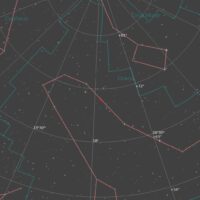
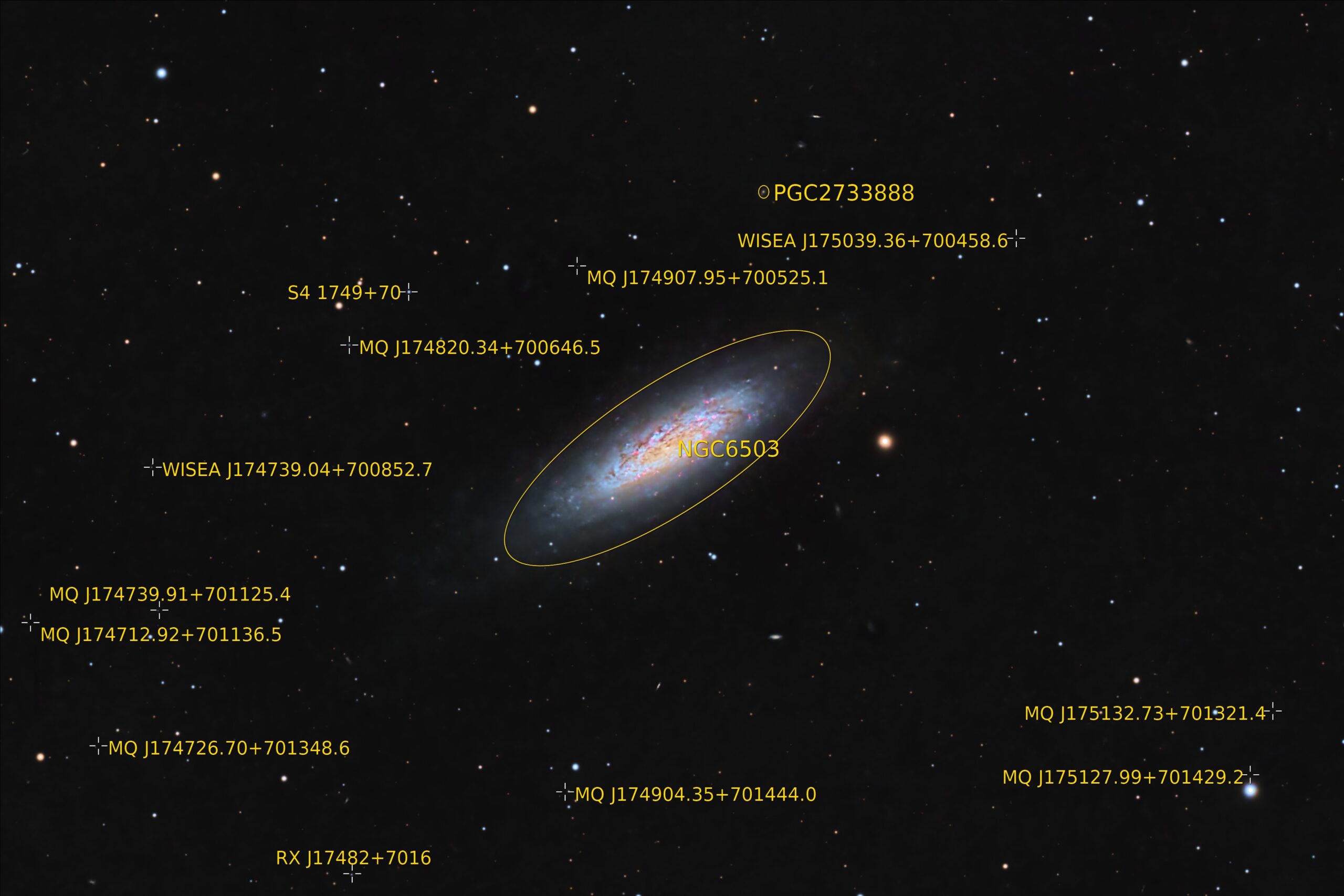
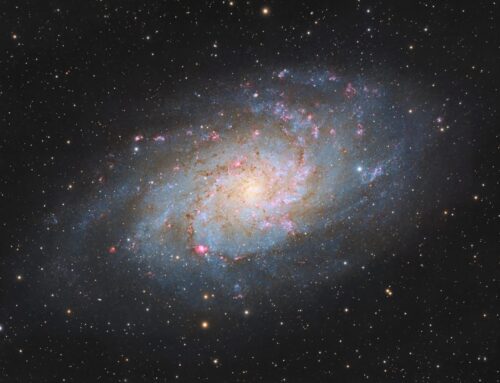

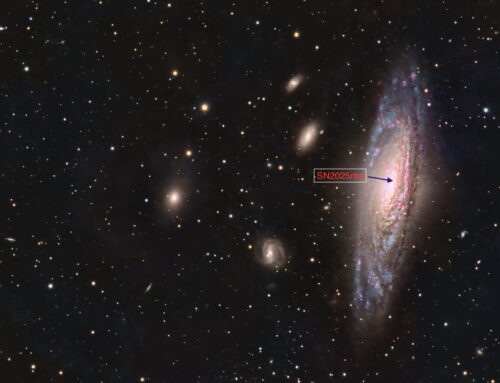
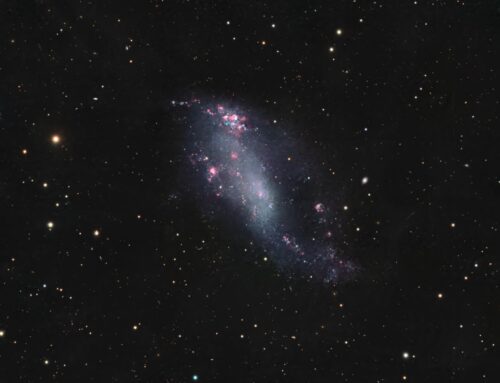

Leave A Comment